FUERTEVENTURA - FUERTE' ROCKS!
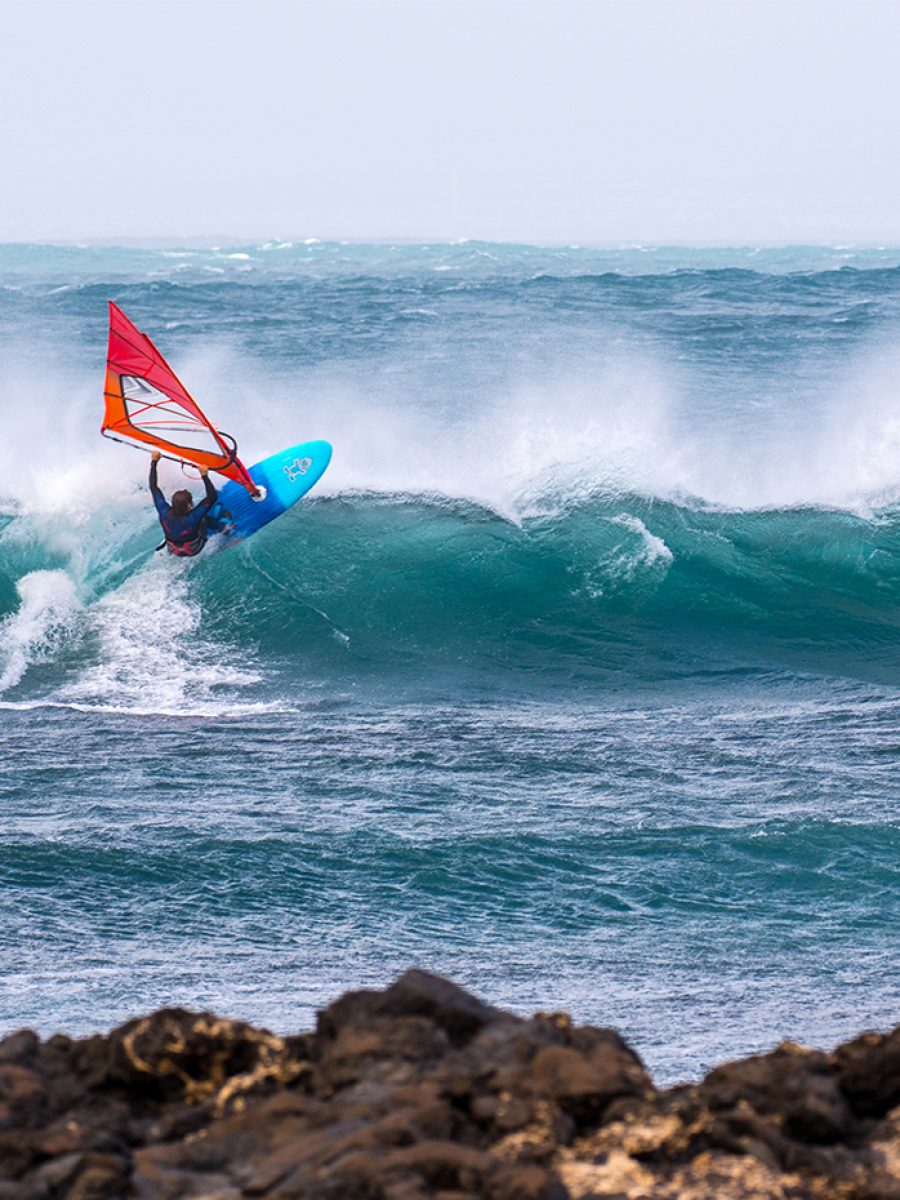
If the Canary Islands are Europe’s Hawaii, then Fuerteventura is Maui, boasting the greatest number of side-shore spots in the archipelago. Rich in windsurfing culture, the island played a formative part in windsurfing’s golden years and still plays host to World Cup events every summer. With the help of some locals and expats, Finn Mullen takes a closer look at the island, past and present and finds out why Fuerte’ rocks!
Words Finn Mullen, Bouke Becker, Will Ward, www.rene-Egli.com, Flag Beach, Ion Club, Stephen Gibson // Photos Katie McAnena, Finn Mullen, Gabor Balogh, Gary Fisher, Bouke Becker, Victor Moncloa, www.rene-Egli.com, Flag Beach, Stephen Gibson, spot-shot.com & John Carter.
This feature originally appeared in the June 2018 issue of Windsurf Magazine.
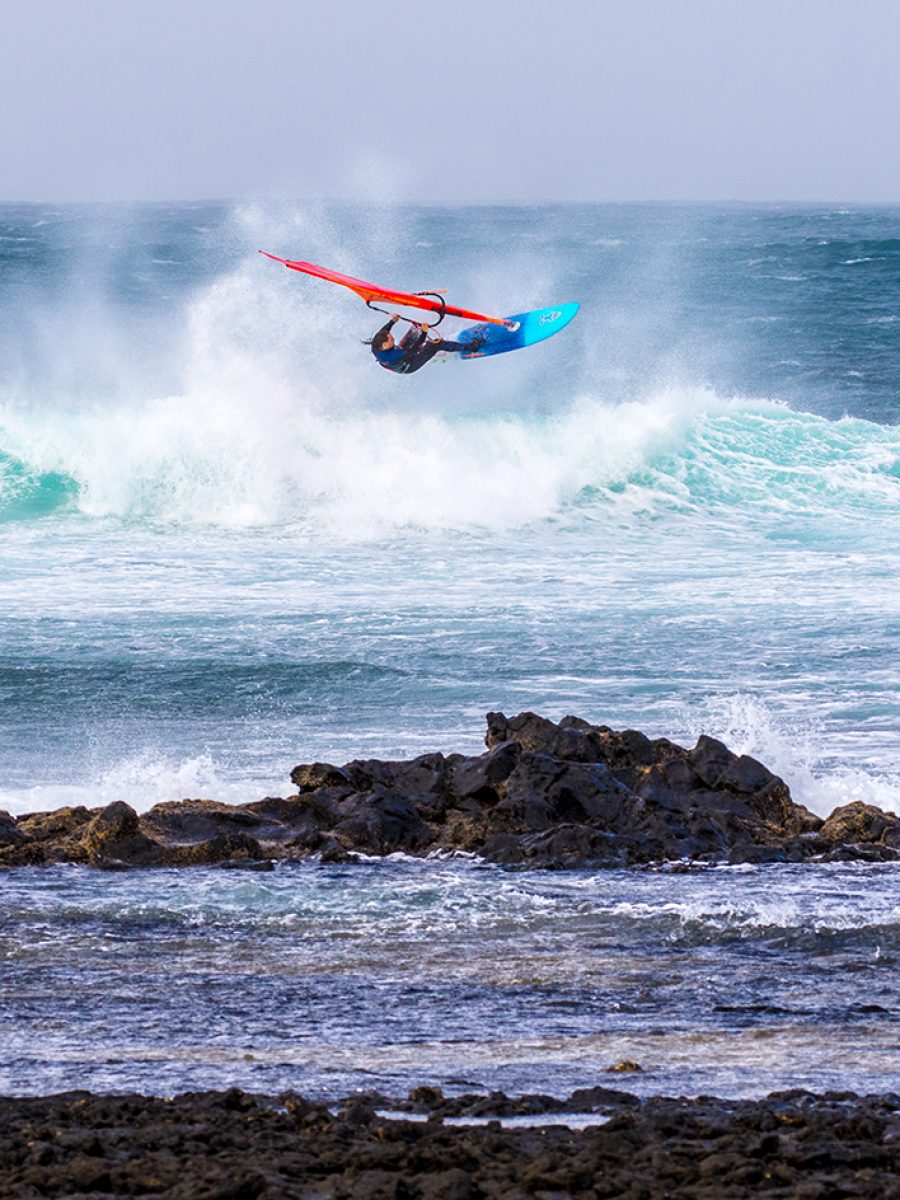
FINN MULLEN
I’m camped out on the edge of town, sleeping in sand, dirt and dust, the grains of this isle. Vans of nomads are scattered along a bumpy trail, their faint fires a distant glow in the night. Someone says the man in the rusting Renault is on the run from the police, I’ve seen him, I believe them. I’m here to windsurf, others are here to escape, we’re all escaping. It’s the end of the eighties, the neon’s beginning to fade and everyone’s looking a way out, Fuerte’ is the ticket. Mornings are slow, the town sleeps, everyone sleeps, even the wind. The waking starts with the Germans, curtains parting on their well built vans by well built men. Blonde and tanned with women the same, they want the wind first. I wait for my lift to the beach, it won’t be long, the commute has started for the ‘No Work Team’. I meet more Germans on the beach, they’re naked but nobody seems to care, even though it spoils the pristine view. Sand whispers over the road as the breeze begins. Clear sea, clear sky, clean wind. Sail, sleep, repeat. Life here is quiet, tranquilo.
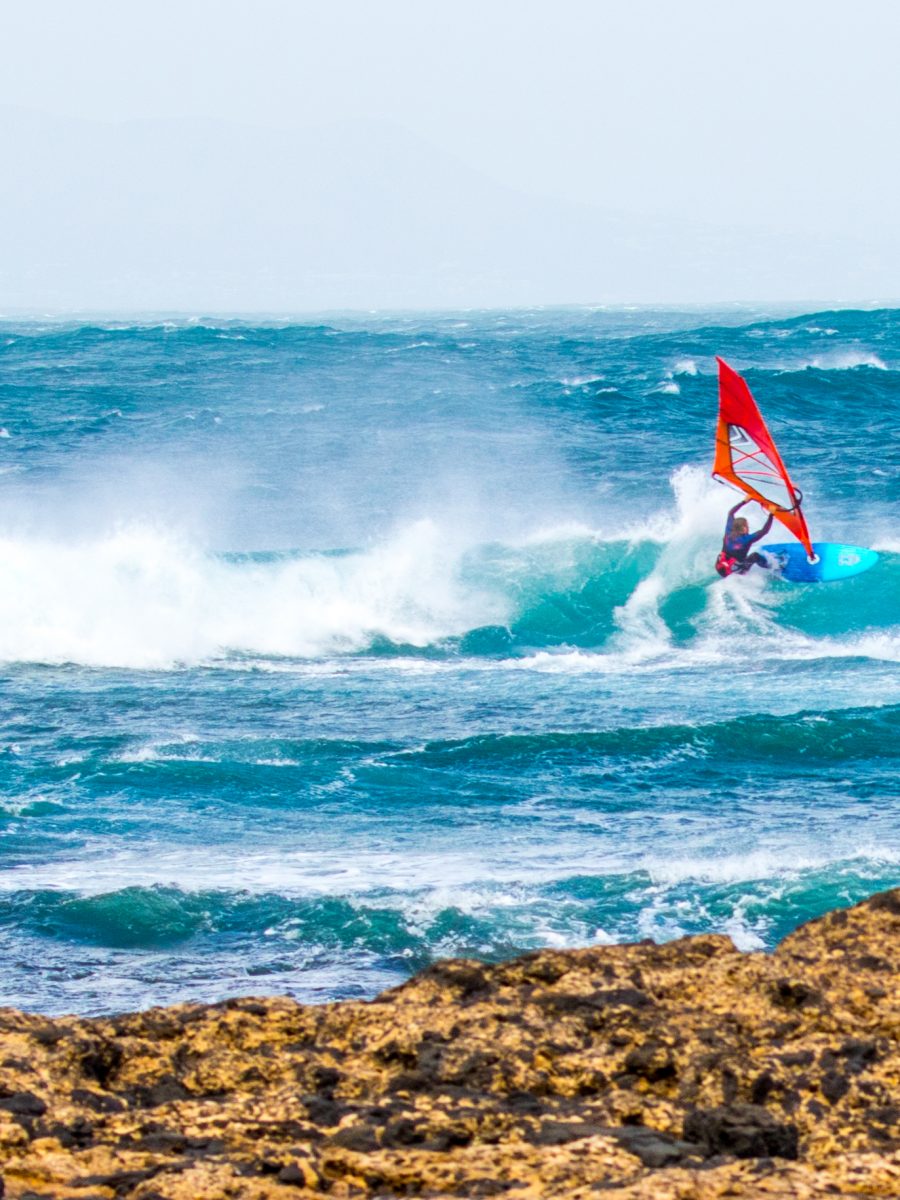
PRESENT DAY
Nearly thirty years on, I’m back In Fuerteventura, keen to see how the recollections of my youth match up to the island’s current guise. Having travelled throughout the Canaries, I remember the winds on the north shore being lighter than the other islands. Back in the day, floating on your wave board was a precarious balancing act, best suited to the scrawny grommet I was. Fast forward a few decades and kilos later and I’m plugging my 5.0 into a super easy to sail and float on 94 litre wave board, no delicate balance required, the ease of use of modern equipment makes Fuerte’s dreamy shores even more of a pleasure. Present – 1, past – 0.
I’m sailing at Flag beach, just a few minutes outside of Corralejo, the main town on the North Shore. It’s easy sailing on a hazard free beach and the perfect way to wash off the stains of travel and convenient to our cheap hotel at the edge of town. My first trip to Fuerteventura required no warm up sail on arrival as I’d sailed over from Lanzarote, underpowered on too small a sail and too small a board. For the record, I’d take flying over reaching any day; it was that sort of a sail! But back then it was all part of the experience, Fuerteventura was edgy. Windsurfing legends and careers were made out of risky sessions on its rocky shores.
Sailors went hard on the water during the day and sometimes harder in the bars at night. I can remember reading about their exploits in magazines, normally weeks and months after the event. Photographers and pros flocked to the island armed with a budget to get the shots and stories that would grab the headlines. Now pros have less budget, their own cameras and little time or money to party while they edit their shots or footage to make sure it’s on the Internet in a matter of days if not hours. The dynamic has changed and Corralejo with it, less beer, more coffee, not a bad thing. The boom of surf fashion in the 80s and 90s saw the fortunes of Corralejo’s traders soar in t-shirts and boardshorts, especially the infamous ‘No Work Team’ brand which encapsulated the laid back lifestyle of the island in cotton. Globalization has caught up with Corralejo now, with its main street dominated by big retailers and the look of a young, vibrant economy save for a lone house, standing up to the modern in defiance with its wooden front door. The clothes may have changed but the north shore’s rebellious character is still there amidst the abundance of tourist accommodation and modern convenience.
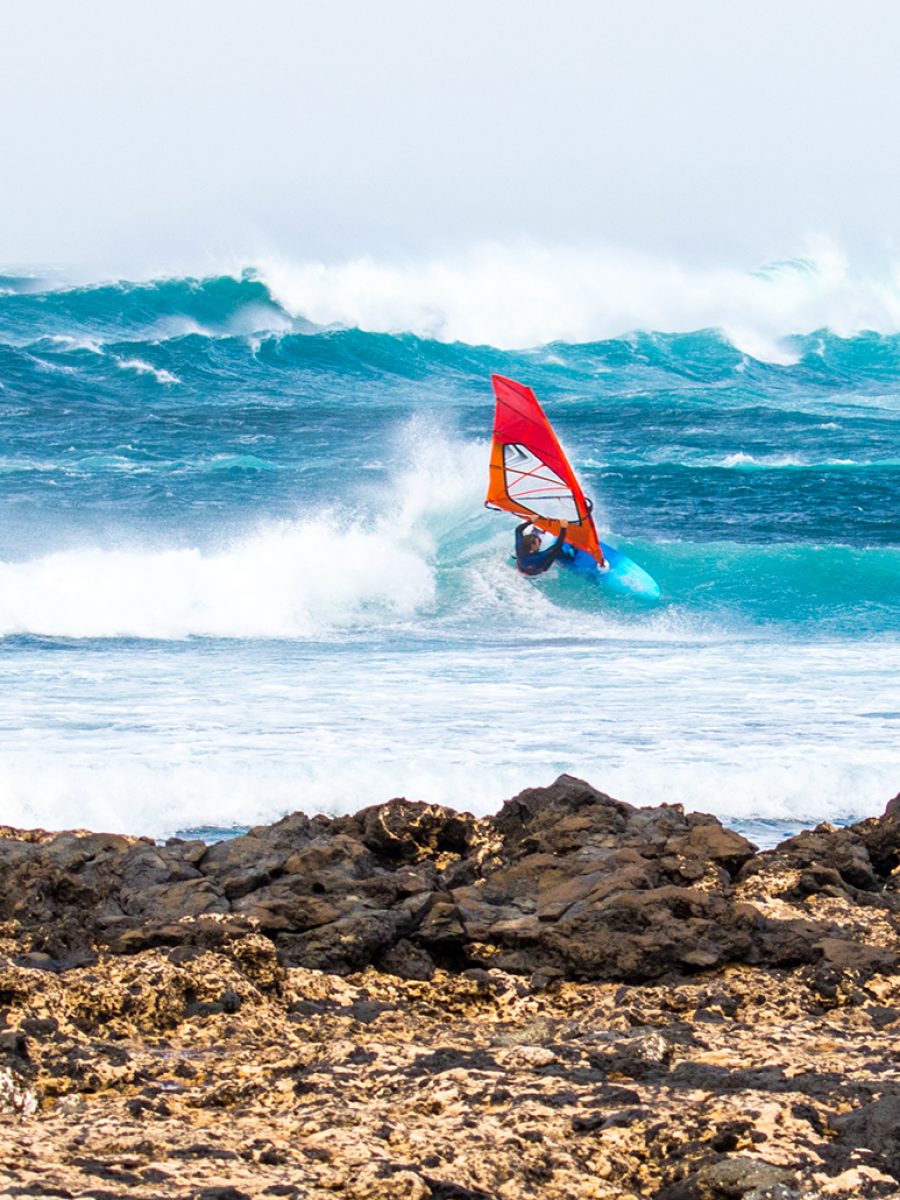
EXPLORATION
The dirt road out of town leads to the mystical ‘north shore’, almost immediately a series of world-class reef breaks are revealed. The terrain is barren, think Mad Max not Avatar, but there’s beauty in its otherworldly spaces and age has not changed its wildness. The driving is the sort of stuff Top Gear specials are made of; rental cars come here to die. It’s wave sailing on the edge of the earth. The varied coastline offers options for most wind and swell directions. Even with the advent of better forecasting, the daily hunt for the best spot remains part of the attraction for sailing here if you want more than a windsurfing resort experience. But Fuerteventura has that too, the south of the island offers flat water and consistent winds and now, new hotels and accommodation options to service the sailing in Sotavento, Costa Calma and Risco Del Paso. Criss-crossing the island, north to south on a wind hunt has become easier with upgraded roads, but has the increased infrastructure dulled the island’s personality? Increased tourism can make it harder to get under the skin of a place and let it reveal its true self. I walk down to the beach by the harbour, unfinished developments tell a tale of expansion too quick. The island’s changes have pros and cons, but it has still retained that quiet, unhurried manner, that feeling of escape. The long coastline still feels open to adventure. You could stick with one spot and lock in to whatever tack or degree of side-shore you prefer or explore the variety on offer. Local shaper and guru, Bouke Becker of Witchcraft Windsurfing tells me, “We have more spots along the east coast where you could sail when Glass beach is working, but hardly anyone goes there…. In winter time we have so many point breaks that we hardly ever sail side-onshore conditions.”
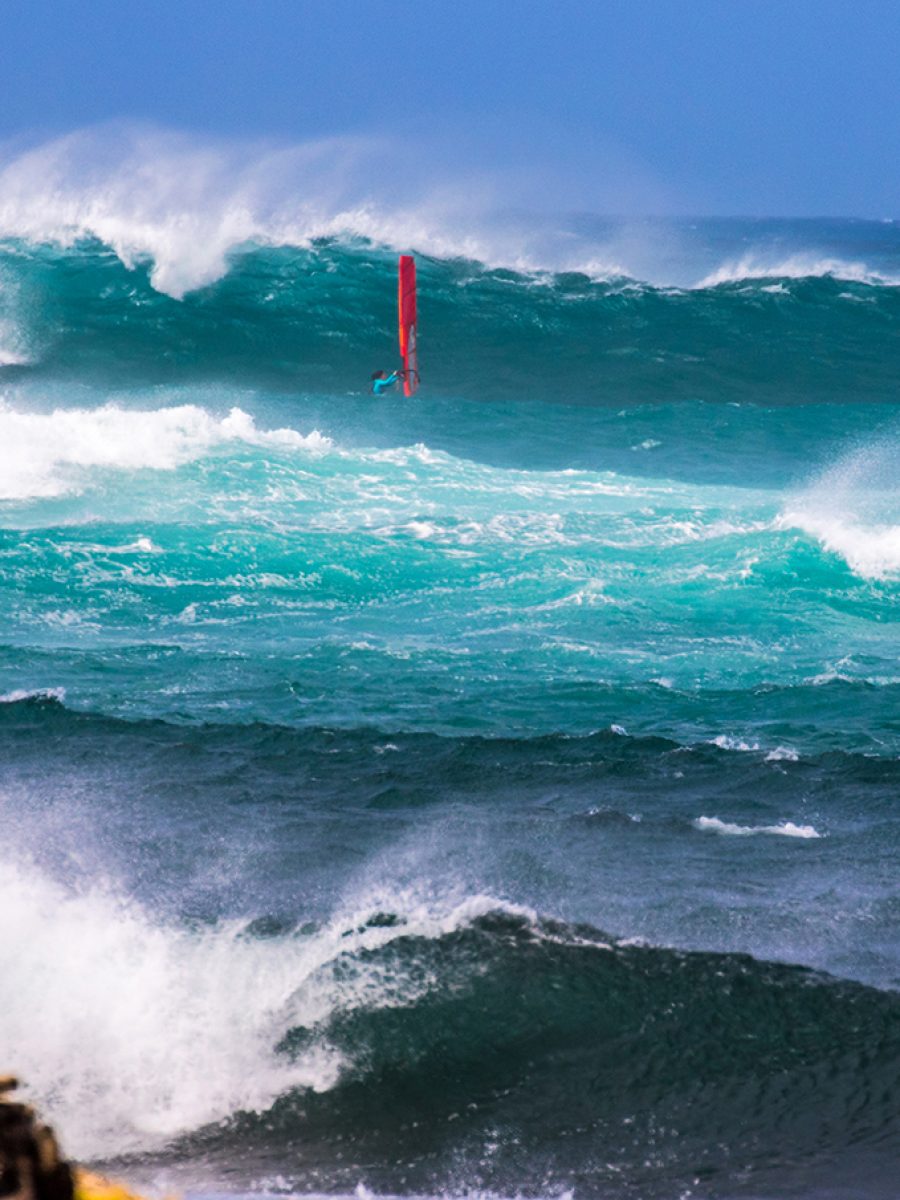
PERFECT PLACE
We spend mornings and evenings in the sheltered waters of Corralejo, perfect for swims with baby, SUP and freeride / beginner windsurfing. A short walk away is Rocky Point, a convenient break for catching some waves, sailing or surfing. For families looking to spend less time in a car and more time in the sea on their holidays, Corralejo is a brilliant base. Chilled out tunes play from the beach cafes for the post Ibiza generation and we watch the evening sun illuminate the views of the island of Lobos with an eclectic crowd. Old ravers, surfers, hipsters and holidaymakers, Fuerteventura has a place for them all.
It’s time to head home and as I walk through the departures area of the island’s modern airport, my eye is drawn to the TV screens playing windsurfing videos on loop in a large shop. Intrigued I look closer at the sign above the door – ‘No Work Team’. The island and the ‘Team’ have all grown up since last time I visited, but thankfully not so much that they’ve let go of their roots. Fuerteventura is still, and always will be, a great place to windsurf and escape to the sun.
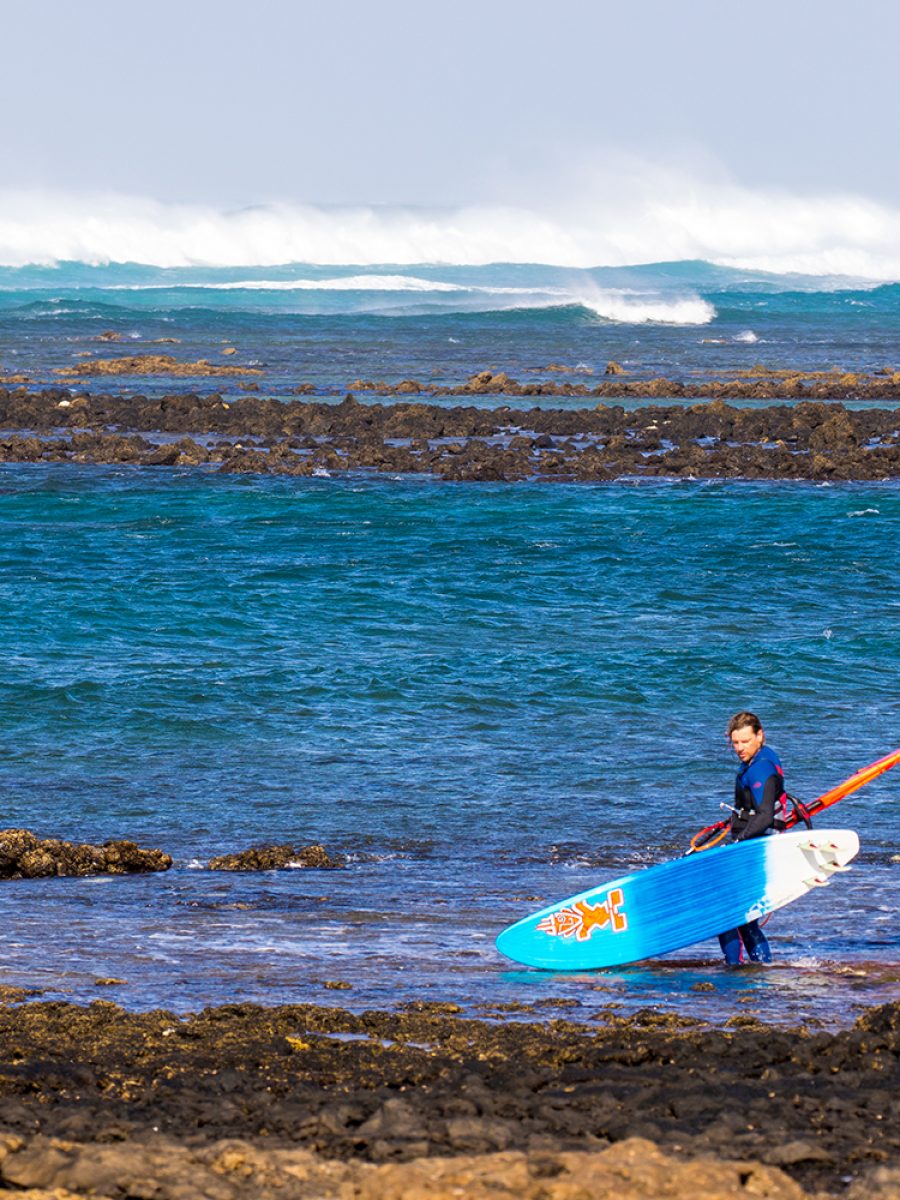
BOUKE BECKER – WITCHCRAFT WINDSURFING
Windsurfing on Fuerteventura is mostly about wave riding. We have over 15 spots to choose from for different wind directions, wave size or type. We can nearly always sail somewhere side or side-offshore and nearly all spots are point breaks with a channel downwind. Wave riding does not get much easier and more fun than that. When it’s side-shore, you don´t want too much wind, as it’s much easier to keep speed on the wave. There is hardly any rip either. Even if it is big, you see where the peak is starting and as long you stay downwind of the peak, nothing will happen and you can just carve up and down on the shoulder. With 60% of the waves coming from the N-NW, we also have much more days with waves, even if the wind is light. Our jumping spot is Punta Blanca, which is cross-onshore. Facing NNW, it gets a lot more waves and the reef slopes very gradually so the surf breaks further out and you have a good run up to the waves. If you get washed, you don´t end up on the rocks. Over the year we get many quality wave sailing days. You can also sail higher winds at Sotavento in summer or you can go freeriding in the bay of Corralejo towards the island of Lobos in beautiful surroundings and crystal blue waters. Sailing between islands is a very different feeling than just sailing out into an open ocean.
CHANGE
Windsurfing wise nothing much has changed on the island really. There are years with more wind or waves and years with less, there are still the same amount of people on the water. One difference is kites, at some spots they go out between 20-30 windsurfers where there is not really space enough for them to keep a safe distance away to others. But at most spots they have alternatives and they are getting banned more and more.
Non-windsurfing wise more has changed; population and tourism has grown and with that the infrastructure. With the new motorway it’s 20 minutes into Puerto Lajas, which used to take 30-35 minutes. Despite the growth, there is still enough space; the island is nearly as big as Tenerife, but with only a 1/10th of the population. In the old days we´d have beach parties with a fire and we could drive our 4×4´s on the beach. Lajares has grown to be the surf city of the island, probably the only surf city in the world without a beach. Life on Fuerte’ is not as smooth and well organised as it is in western European countries. You learn to become patient and grow a thick skin. Simple things can be quite difficult to organise. On the other hand, you will need to look very hard to find someone in a suit with a tie and no one looks at you if you wear boardshorts and flip-flops.
WILL WARD – UK RIPPER
I came on a holiday with Andy Funnel and John Skye and never left. The original plan was to spend a year on each island, but that never happened. Basically where I lived in the UK was horrible, far away from any sea and I had to get outta there. The warm weather, consistent winds and waves was a dream to me. Fuerte’ is great but sometimes you gotta leave to make you appreciate it again. But that’s good, sometimes it’s cool to visit other places and be happy to come back as well. Now I tend to pick the good days to windsurf and I go motocrossing, downhill mountain biking or tow-in surfing as an alternative.
“I came on a holiday with Andy Funnel and John Skye and never left.”
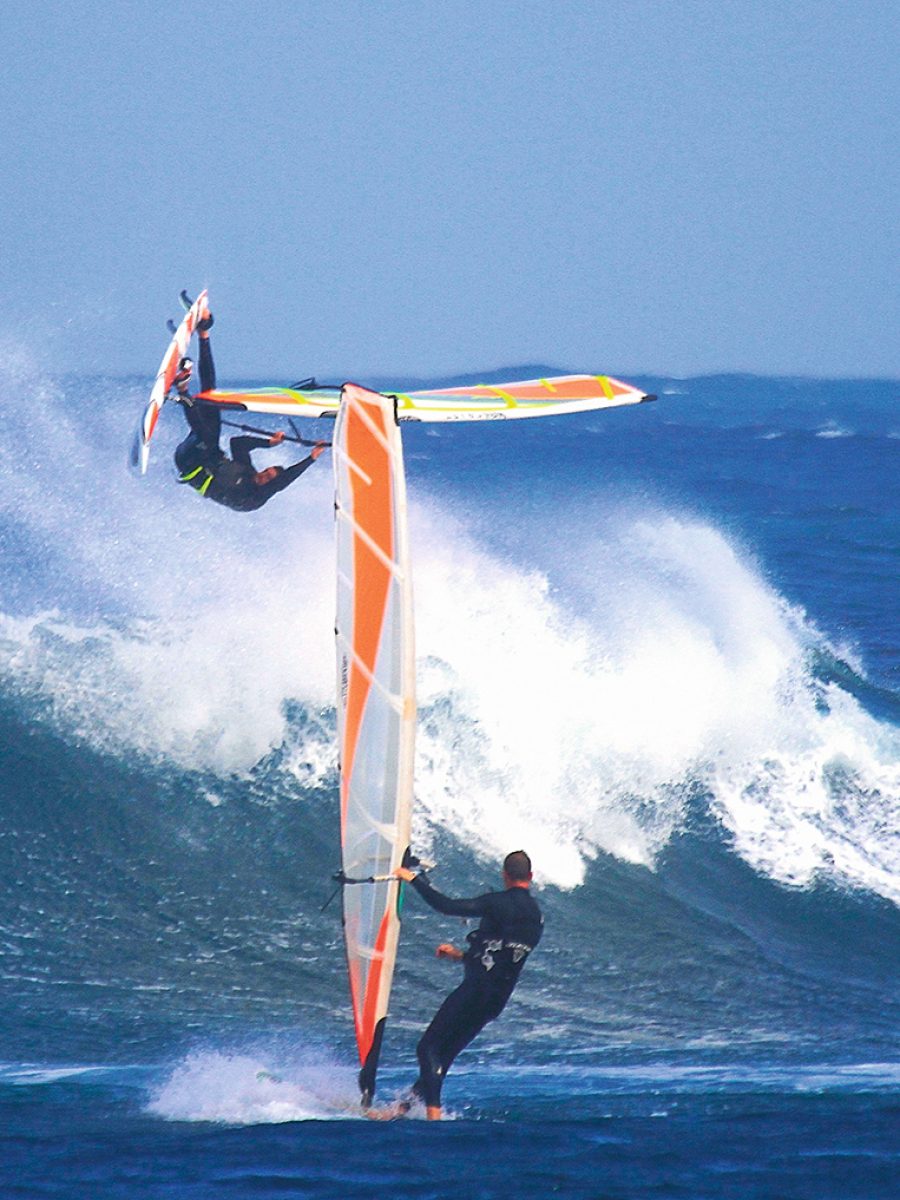
ION CLUB
For windsurfing, Fuerteventura offers excellent wind conditions throughout the year, and because of that, the island became one of the most popular windsurfing destinations in the world. One of the beaches that has it all is Risco Del Paso, in the south of the island. Here you will find an awesome lagoon, surrounded by white dunes, a small wave area, freestyle area and flat water, where you can practise every variant of windsurfing. The shallow water in the lagoon is also a great place for learners. The north part of Fuerteventura is more wave oriented, with spots like Cotillo, Glass beach, Flag beach and Majanicho the most popular.
Windsurf centres are continuously improving their service and most importantly, offering highly professional safety cover on the beaches with rescue boats and lifeguards all year, providing safety to customers in all conditions. The Canary Islands are special, Fuerteventura in particular. Living here means being in a beautiful place 365 days a year, with great weather and sharing your life with happy local people.
“The Canary Islands are special, Fuerteventura in particular.”
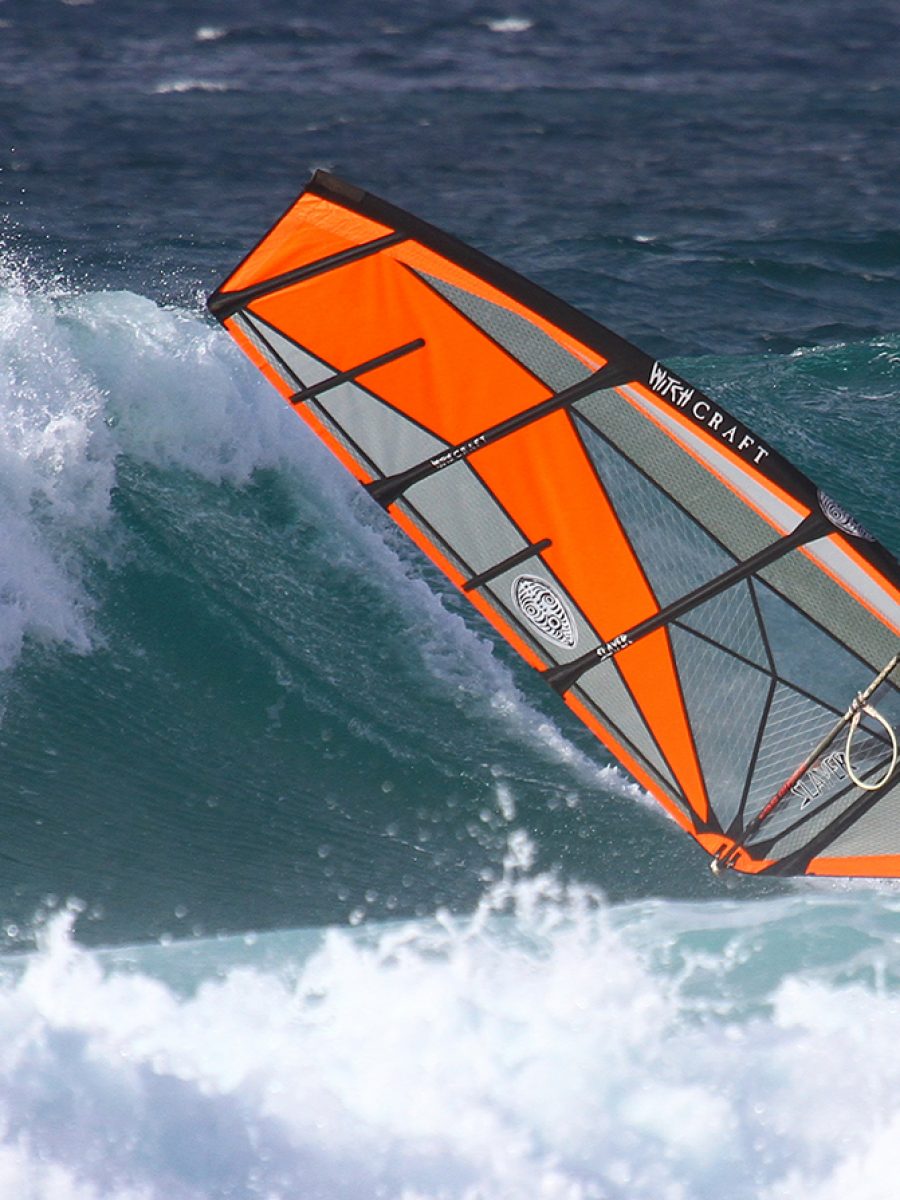
FLAG BEACH
This year Flag beach will have been here 30 years! It seems a lifetime away when Ben Thomas secured a beach licence and plonked a Maersk shipping container on a windy and deserted beach close to the small fishing village of Corralejo. It was the 1980s and windsurfing was booming. The island was a predominantly German tourist destination. A quiet, windswept desert full of roaming goats and nudist lovers on the wide open beaches. Hardcore windsurfers drove their old Suzuki jeeps across the dunes to check the wind and waves. There were crazy tequila nights at the Arena Bar and Kiwi bar or later Corkys as the only watering points after a ‘Big Wednesday’ at Cotillo or a long session down in Jandia. Corralejo became a surf Mecca alongside attracting the masses to its sun worshipping weather and easygoing culture. Corralejo is now a mass of restaurants, shops and bazaars with an incredible and international vibe.
Visitors come from all over Europe with flight connections readily available across the continent. We have a dual carriageway and Burger king and hotels that are full all year round. We are no longer the quiet, sleepy fishing village and we can no longer drive to the water’s edge, but the island is still a very relaxed place. Windsurf visitors are no longer the main market but we still teach plenty of people who come here to learn to windsurf. Indeed we are now teaching the children of those that learnt here in the 80s! The conditions are still great from Glass beach to Cotillo and the view from our shack at Flag beach is still as sandy, sunny and awesome as always. You can take kit away at Flag beach to sail other spots and as petrol is cheap it’s a good idea to hire a car to follow the wind and a 4×4 isn’t necessary. Self-catering apartments or villas are a good option for smaller groups as they work out quite cheap per head, or for single travellers there are a lot of surf camps with plenty of accommodation options to choose from.
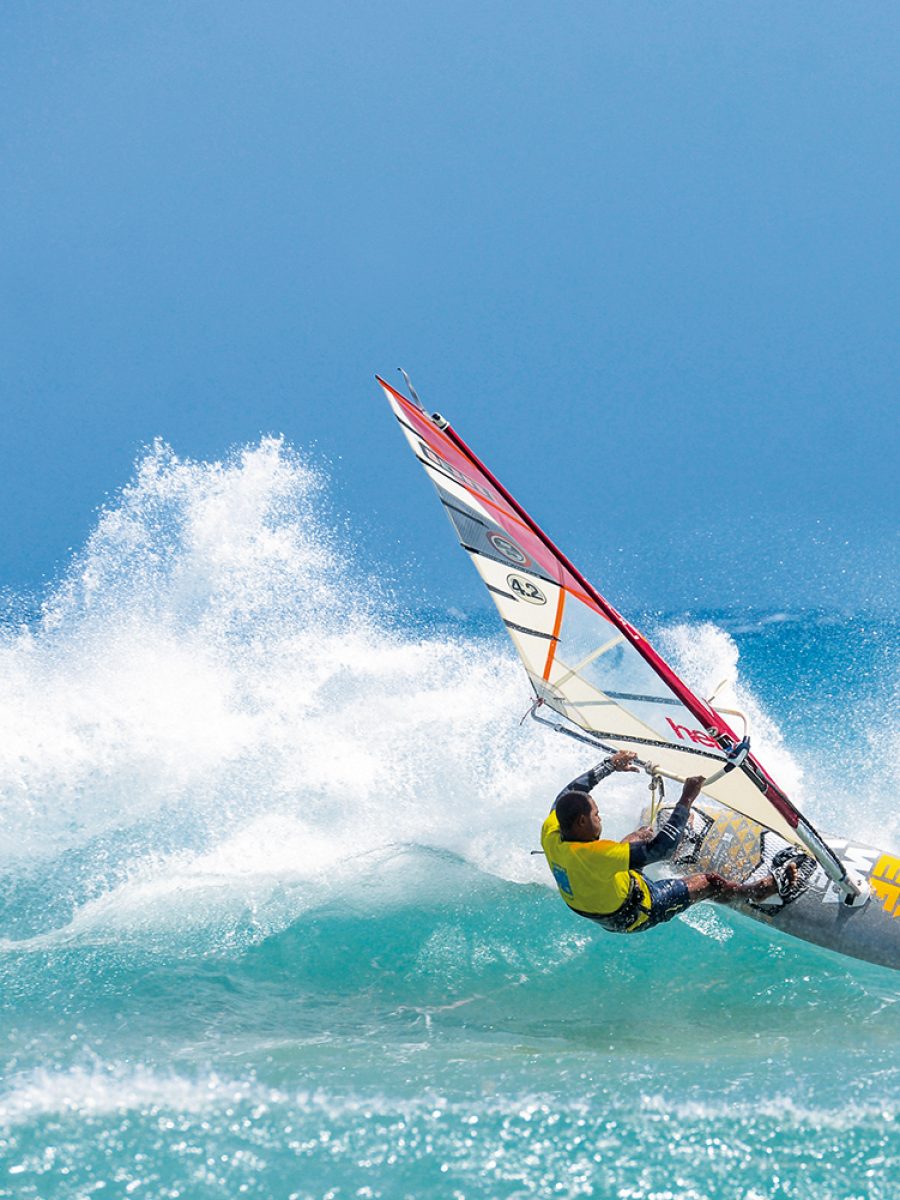
RENÉ EGLI
The island of Fuerteventura has experienced significant changes in the past 20 years, especially with regards to improvements in tourism infrastructure. The latest proof is the newly opened Sol Beach House at Meliá Fuerteventura, which welcomes adult guests in a unique and relaxing beach ambiance combined with excellent gastronomy. All just a short walk away from the René Egli Windsurf-Center equipped with the latest kit. Wind conditions remain as outstanding as 33 years ago, when the annual World Cup tradition at this spot started with the legendary world record of Pascal Maka with 38.86 knots. Nowadays all generations enjoy our great windsurfing conditions, no matter if beginner or pro, maintaining a high demand for rentals as well as courses. With year-round pleasant air and water temperatures as well as dreamlike beaches and a tidal lagoon, Fuerteventura’s popularity is increasing year after year, providing all you need for a perfect vacation and just a short flight away from the UK.
“ Fuerteventura has experienced significant changes in the past 20 years.”
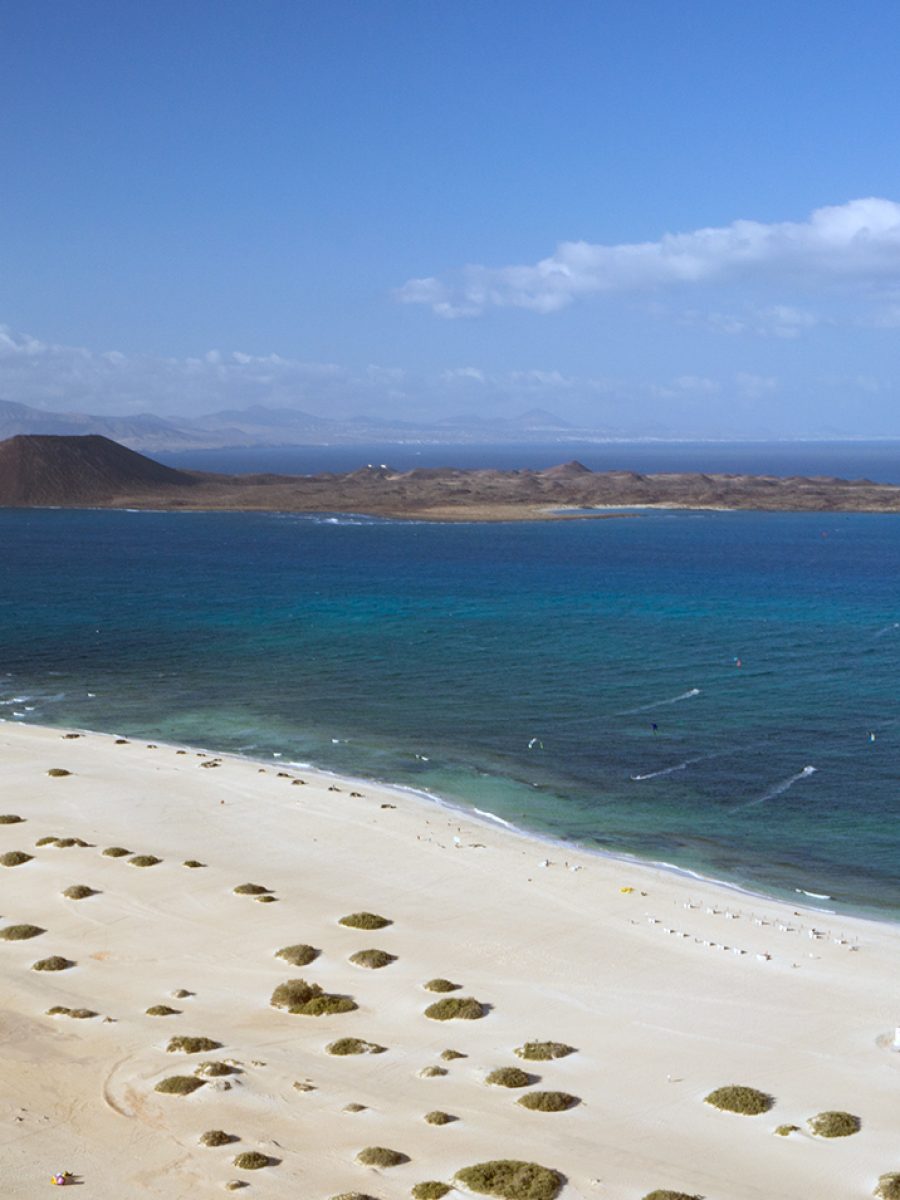
STEPHEN GIBSON – EXPAT SHREDDER
Until the age of 17 I was a regular competitor on the UK wave, slalom and course racing circuit (the BFA back then). In 1987 university beckoned and with it the attraction of more hedonistic pursuits, causing windsurfing to fall completely by the wayside. In 1992 as a fresh faced undergraduate, not having touched a windsurf board for four years, I decided to get into training to compete once again at a national level. I soon realised however that the local conditions up in North East England are too inconsistent and not entirely conducive to full-on wave sailing training, so I formulated a cunning plan! My dad had recently come back from a windsurf trip to a mystical island off the coast of Africa with perfect waves and constant trade winds – Fuerteventura. I decided to save up for a year and head off there for six months solid training before coming back to compete in Tiree in October. In May 1995 I landed in paradise, Fuerteventura, and the next 6 months were spent windsurfing all day every day and washing dishes in a restaurant in the evenings. In October, when my 6 months were up, I quickly re-evaluated. I had a job, an apartment, a new windsurf sponsor, a rusty old Fiat Panda (they were all the rage back then!) and I was windsurfing in perfect conditions every day in boardshorts. Suddenly the thought of returning to Newcastle had somewhat lost its appeal. I ditched my return ticket and never came back.
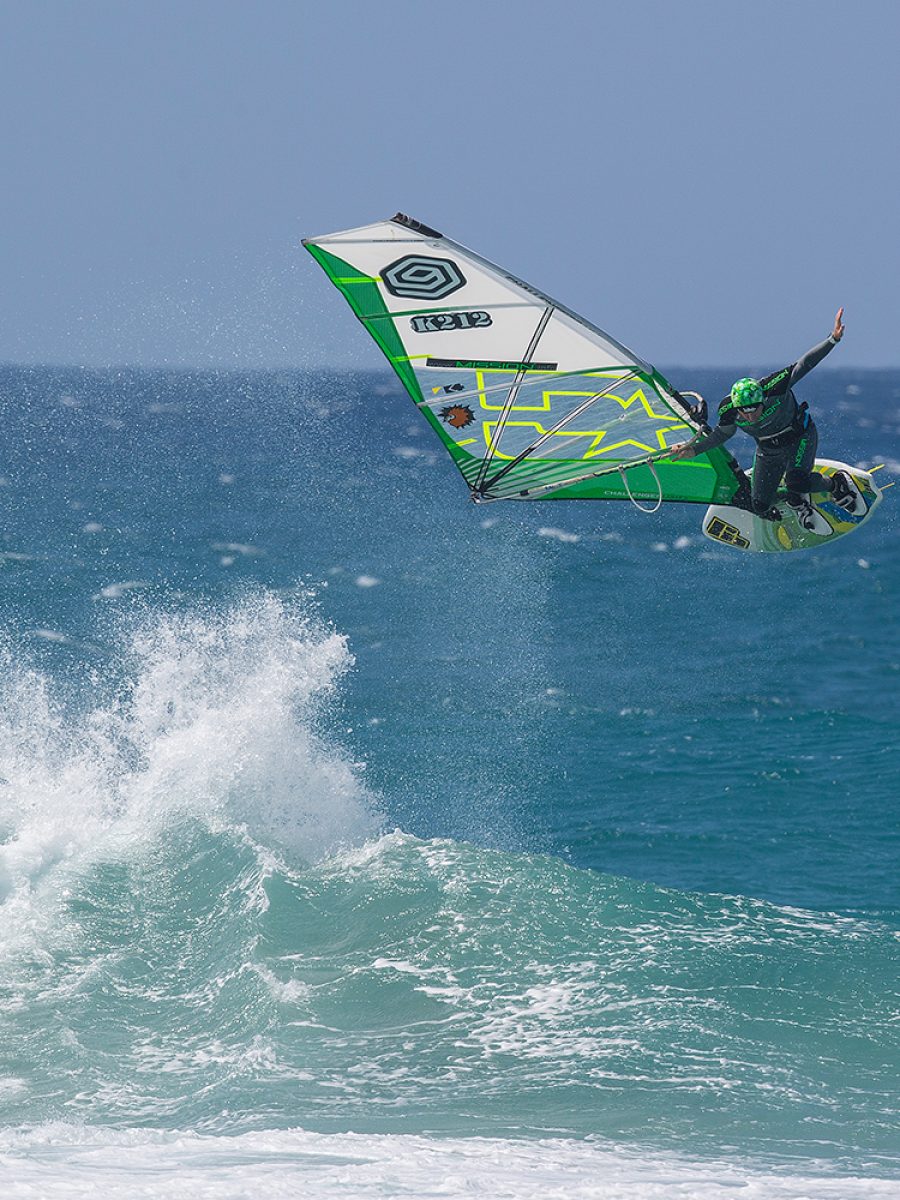
It’s been an absolute blast, the best decision I ever made. I graduated from dishwasher (underwater ceramic technicians we called ourselves) to head chef in some big hotels, eventually opening my own restaurant which I ran for 10 years. Now, I’ve gone back to my academic roots and have my own language academy in Corralejo, working 4 nights a week and with the added bonus of Spanish school holidays, roughly translated as 2 ½ months off during our windy summer. Coincidence, I don’t think so ha ha.
Obviously over the years I have seen some big changes in Fuerteventura and, in particular, in Corralejo, my base in the north of the island. Corralejo has expanded substantially from the little sleepy fishing village it was back then and it’s way busier, but the island has retained its laid-back, surfy vibe. Driving to my favourite spots along the bumpy dirt track on the north shore I still feel the same exhilaration as I see the turquoise ocean peppered with whitecaps and the Atlantic rollers battering the rocky coastline. I won’t be leaving any time soon!
“ I won’t be leaving any time soon! ”
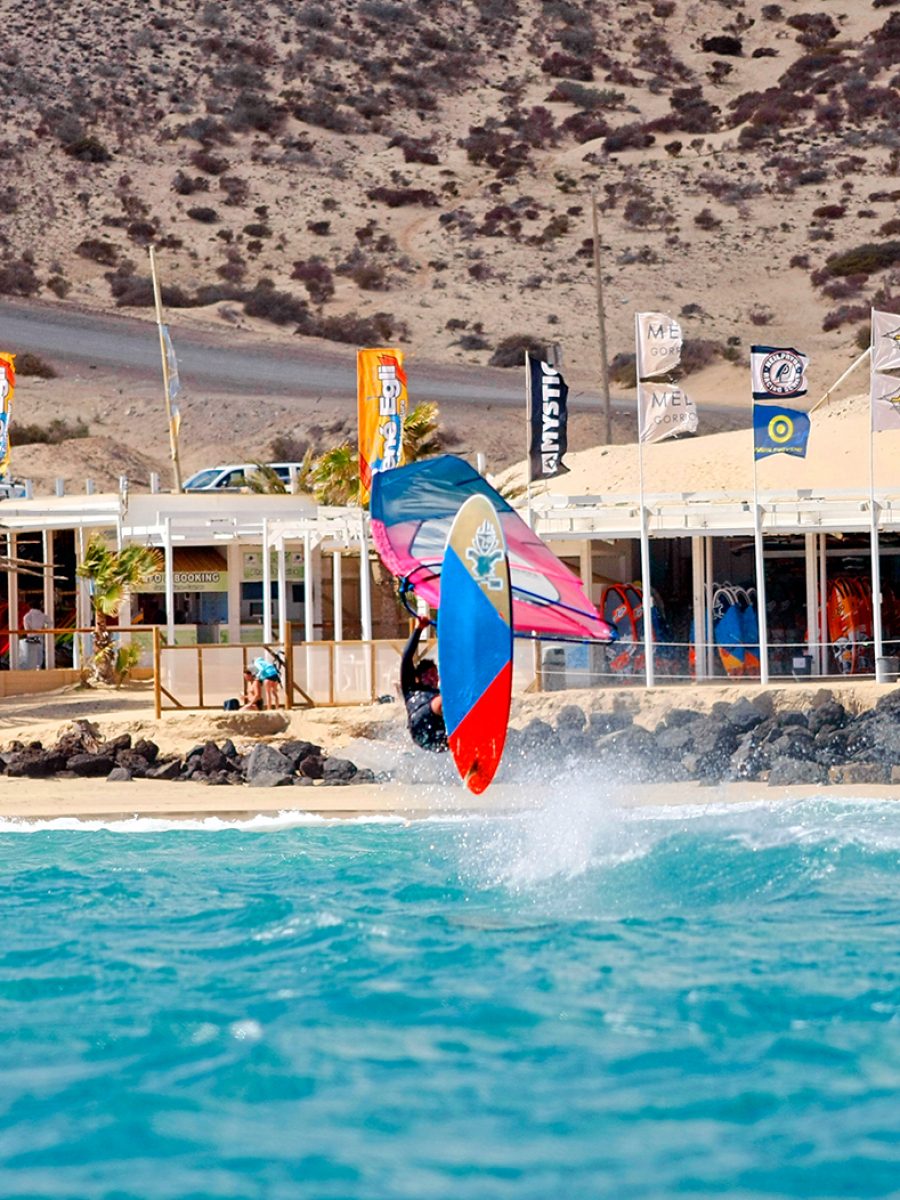
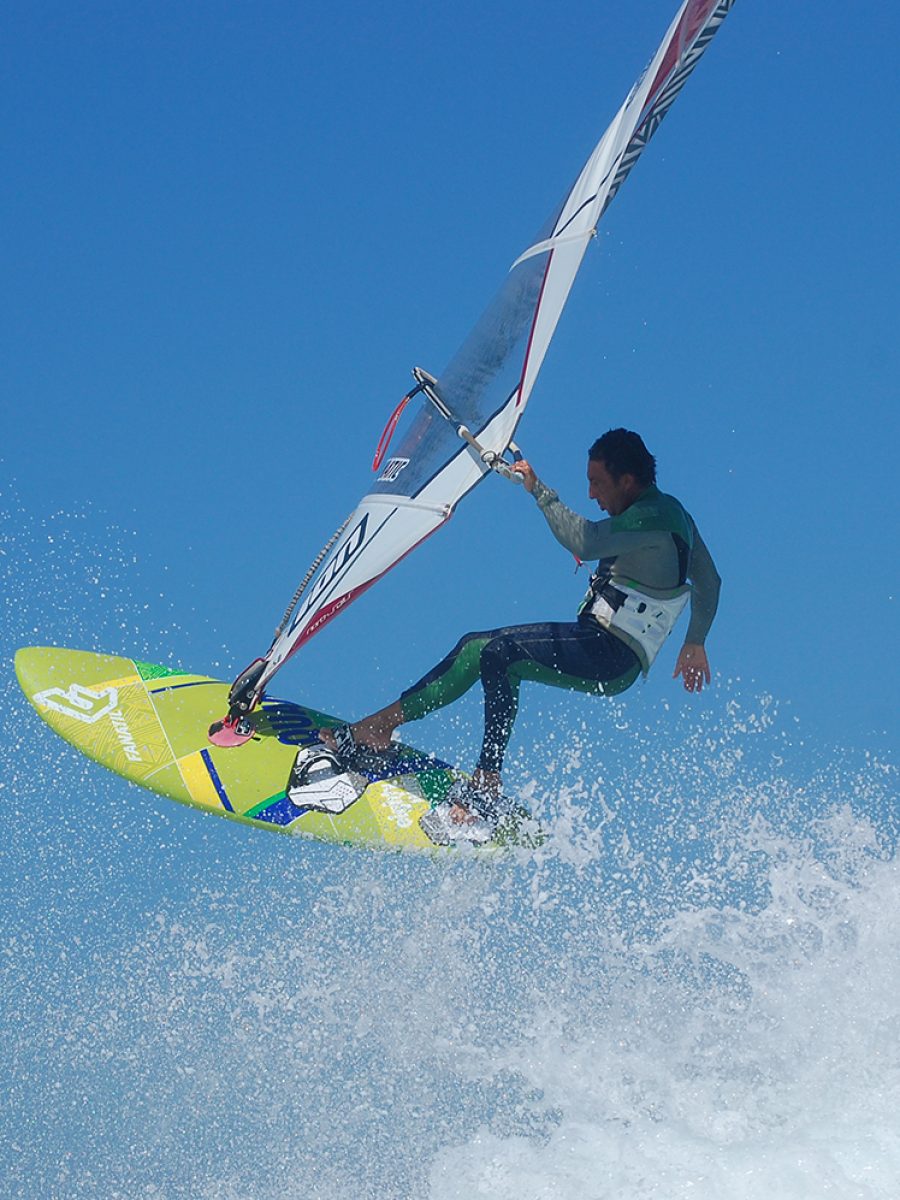
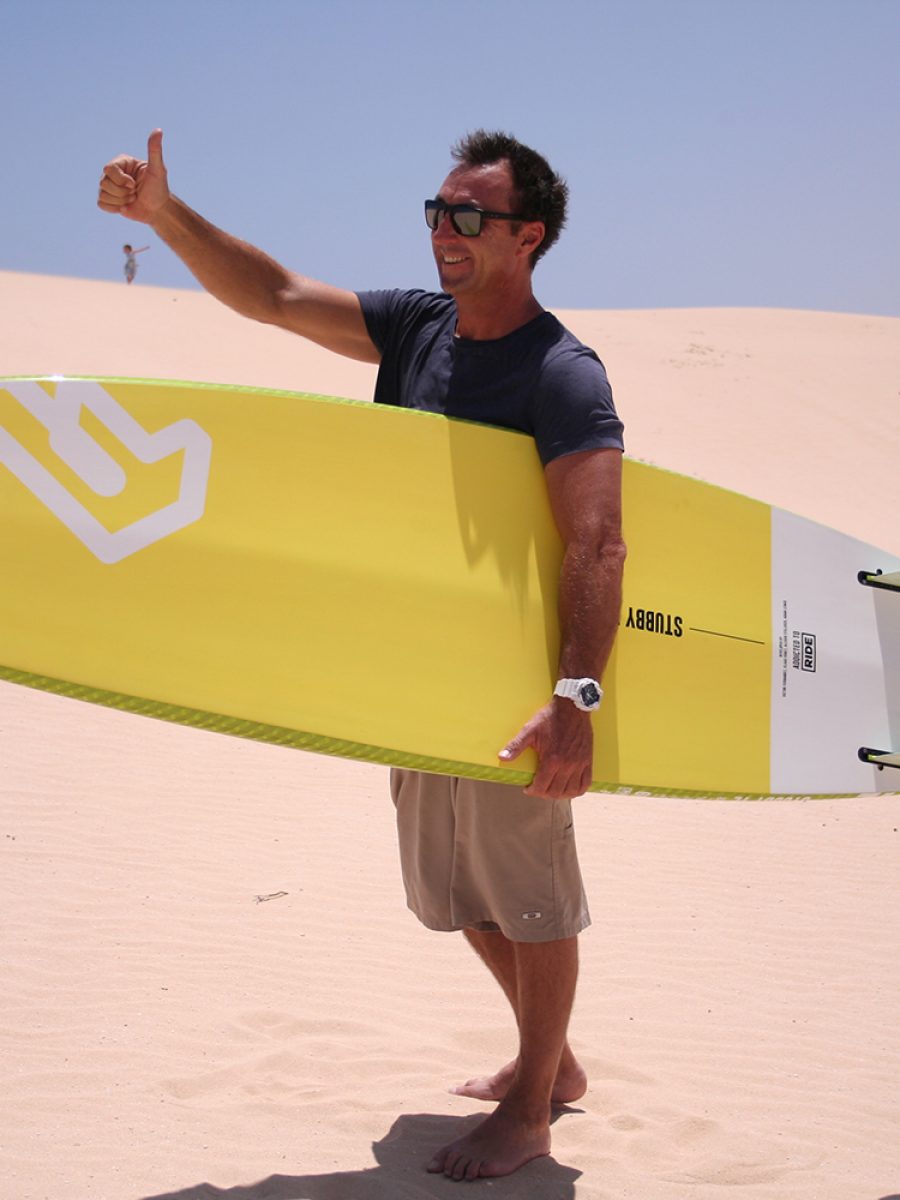
The post FUERTEVENTURA – FUERTE’ ROCKS! appeared first on Windsurf Magazine.